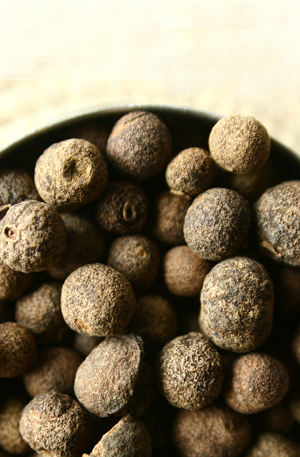

Jamaica Pepper, more familiarly known as allspice. Photo by B.A. Van Sise | THE NIBBLE.
| WHAT IT IS: Varietal peppercorns—20 different pepper types and counting. |
|
WHY IT’S DIFFERENT: Each origin of the world produces pepper with different aromas and flavors—just like coffee beans and chocolate.
|
| WHY WE LOVE IT: Another way to vary food accents—and it has no calories! |
| WHERE TO BUY IT: Pepper-Passion.com, Kalustyans.com. |
|
|
|
KAREN HOCHMAN is Editorial Director of THE NIBBLE.
|
|
|
 |
Varietal Peppercorns: Spice Up Your Life
Page 6: Pepper Glossary K To L
This is Page 6 of an 11-page article. Click on the black links below to visit other pages.
Different Types Of Pepper:
Spice Up Your Life
Page 6: Pepper Glossary K To L
JAMAICA PEPPER (or Allspice or
Kababchini or Myrtle Pepper or Pimento)
Jamaica Pepper is the dried, unripe berry of a bushy evergreen tree, Pimenta dioica, of the family Myrtaceae. The dried berries have an appearance similar to large peppercorns and share some similar spicy characteristics: They are sometimes added to peppercorn blends. The corns are highly perfumed: The name “allspice” was coined by the English, who found the berry to have the flavor of black pepper, cinnamon, cloves and nutmeg all rolled into one. These flavor complexities deliver on the palate as well. Allspice is indigenous to the West Indies but is used in the regional Indian cuisine of Kashmir and in curries of other regions of north India. Christopher Columbus was the European who discovered allspice; although he was seeking pepper and other treasures of the Orient, he had never seen real pepper and he thought he had found it in these berries. He brought it back to Spain, where it was named pimienta, Spanish for pepper. The Anglicized name, pimento, is still occasionally used in the spice trade.
Use It: Crushed on venison and other game, whole in marinades and braises, on barbecue, in rotisserie seasonings. Of course, allspice is a major ingredient in jerk seasoning. It was one of the spices used by the Aztecs to flavor their chocolate beverage.
LAMOPONG PEPPER
See black peppercorns.
LONG PEPPER (or Indian Long Pepper or Roman Long Pepper)
From Bali, one of the islands of Indonesia, Piper longum, cousin to Piper nigrum, was the peppercorn exalted by Romans as the ultimate peppery spice, costing three times as much as the small, round black peppercorn. It disappeared into culinary obscurity with the agricultural domestication of Piper nigrum, to reappear in the West in the last few years with the growing interest in specialty foods. Once ground, roasted or simply snapped in two, the peppers release a complex floral bouquet with earthy nuances and hints of cinnamon and celery seed. The flavor has a depth and complexity not found in regular peppercorns, simultaneously releasing pungency, sweet hints of cardamom and nutmeg and a slight fruitiness. Since long pepper is more pungent than black pepper, it adds a greater depth of spiciness and will be appreciated by those who enjoy the flavor of fresh-ground pepper. The peppers are too large to be ground in a traditional peppermill, but are easy to grind with a mortar and pestle or in an electric spice grinder.
|
|
 The first pepper used by Europeans was the long The first pepper used by Europeans was the long
pepper, which has hints of cinnamon and is delicious ground on desserts, including ice cream and fruit. Photo by B.A. Van Sise | THE NIBBLE.
|
Use It: Long peppers can be used in any recipe that calls for regular black peppercorns. They are terrific with everything from steak to Bloody Marys, and look (and taste) lovely when crushed and sprinkled onto sliced goat cheese or individual chevre buttons. Try them ground with desserts such as roasted pineapple. They are excellent in marinades or cracked to infuse stocks; or drop them whole, like a bay leaf, into soups, stews, tomato sauce or chili. Read our review of Big Farms Balinese long peppers. See long pepper recipes for Watermelon and Long Pepper Shrimp Salad and Long Peppered Steak.
Continue To Page 7: Peppercorn Glossary M
Go To The Article Index Above
FOR ADDITIONAL INFORMATION, special offers, contests, opinion surveys, THE NIBBLE back issues archive, product gift-finder and more, visit the home page of TheNibble.com.

|



